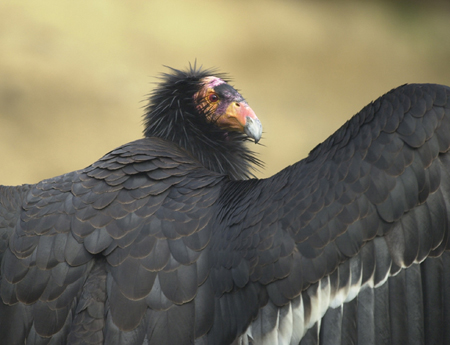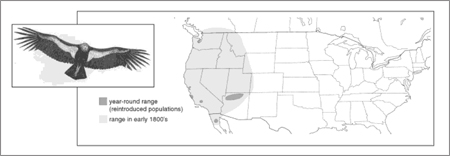
California Condor in the wild
Credit: U.S. Fish and Wildlife Service
This is David posting today rather than Jeff - I learned this week of a wonderful success story I thought I'd share with you for the weekend:
A huge milestone was reached this week when the wild California Condor population reached 100 for the first time in over 50 years.
Also see the chapter in Jeff's book on the California Condor, which provides more in-depth detail on the species and its conservation needs.
The story of the California Condor has been a long and troublesome one. Over the last century the condor population dropped dramatically from a variety of factors, the largest being habitat loss and alteration, poaching, and poisoning from lead and DDT. By 1987 the California Condor population sunk to a frightening 22 birds left on earth.
This rapid decline (finally) spurred increased government action and a conservation plan was put in place. All 22 of the wild condors were captured and put into captivity for the purpose of beginning a captive breeding program, where the goal was to increase the population and begin releasing them back into the wild.
The progress was slow but steady. By 1991 officials felt ready to begin slowly reintroducing the condor back into its natural habitat, releasing more in 1992. In 1996 they released several condors into a separate historical range in Arizona near the Grand Canyon with the goal of returning the two separate populations back to their distinct historical ranges.

Range map from Jeff's book - click to enlarge
While the breeding rates and population increases were slower in the wild, they were nonetheless effective. Condors began breeding without human assistance, and since then the population has steadily grown – today reaching the 100 mark in California.
The goal of the two reintroduction programs is to reach 150 birds in each range with at least 15 successful breeding pairs to ensure progress is not lost. The conservation effort has been long and expensive, but nonetheless proves that with good science, funding, and, perhaps most importantly, a vocal public expressing concern about our endangered species, we can be successful at preventing our most threatened species from going extinct.
I grew up in Northern California and remember hearing about the plight of the condor as a child. Even though condors were not present in the region I grew up in, it was still nonetheless a symbolic bird for the state and I was troubled by the thought that it could easily go extinct. I’m glad, now as an adult, that at least for the time being it doesn’t look as if that will be the case.
In an ideal world we wouldn’t be pushing species to the brink of extinction at such a high rate, but some of the few success stories like the condor can at least give us some hope in the meantime.

